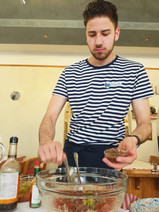Like every gourmet team, we also have a special place close to our hearts, which we rarely write about. Maybe it's better that way, because we are surprised by new flavours, even though we know very well that even the usual ones are so delicious that they could easily be found on various gastronomic portals. Nevertheless, the arrival of steak tartare at Rijeka's restaurant Morčić captured our curiosity, so we tasted the famous dish prepared in front of us.

To begin with, let's discover the whole enigma of the name of this dish. There is controversy over whether it is a steak tartare or a Tatar steak. Linguists reveal the answer to which we cling. Although it is permissible to pronounce both versions, the dish is named after Tatars, not tartare. The latter is a sauce made of mayonnaise, capers and spices that is regularly served with fried squid in Croatia, although originally the sauce was created as an addition to steak and was called "tartare steak" in English. In addition, the stir-fry was made in 1921 by the famous French chef Auguste Escoffier, who wrote it down in his cookbook under the name "Beefsteack à la Tartare".

However, this raw meat dish got its imagination from the Tatars, although there is probably no nation in the world that does not consume some form of raw meat with spices. This dish is said to be associated with the Mongol warriors of Genghis Khan, who conquered Europe on horseback. Legend has it that these Tatars would put a piece of horse meat from under the saddle before a day's robbery. By evening, a softened piece of horse whale could be chewed with a glass of mare's milk. In the Golden Horde, obviously, there was no place for refined dishes.

But the refinement in Morčić is reflected in the knowledge of Leon Babić, the younger son of the owner Kristijan, and waiter Tin Šubat, who deftly showed us how to make steak tartare. "First of all, home-made mayonnaise is prepared, because store-bought mayonnaise cannot be used at all. Squeeze half a lemon, add a teaspoon of salt, a teaspoon and a half of mustard, and an egg yolk. Everything is mixed with the addition of oil. Such mayonnaise is mixed with meat that has been previously chopped. The dry ingredients are added first, then the wet ingredients. At the end, a little cognac, Tabasco, and Worcester sauce are added to this mixture, all at the guest's request," Leon tells us, while Tin prepares our future snacks.

Over the centuries, the dish has evolved from a Tatar brunch to a French delicacy. Eating raw meat was associated with freshness, vitality and health. The horse was still used (boucheries chevallier still have many presences in France), although beef made it the meat of choice due to its durability. Escoffier's recipe called for the finest Breton shallots, Provençal sea salt and Dijon mustard. Only top Parisian restaurants can source such fine ingredients, so many restaurants make it with their own ingredients.
Our tartare is also ready very quickly, which is traditionally served with toasted bread. We believe that there are differences in each chef who adds more or less spiciness, salt and mustard at the end, but the steak tartare we tasted had an excellent balance in the unmistakable taste of quality meat and spiciness. And while we ride in our minds through the Central Asian steppes, Morčić once again proves to be our little Rijeka oasis of exceptional flavours that we often jealously keep only for ourselves!










Comments